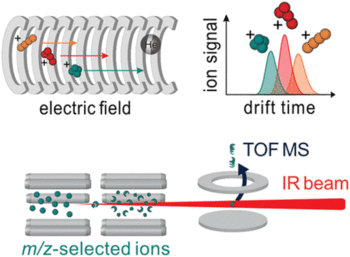New Publication in Accounts of Chemical Research
Gas-Phase Structural Analysis of Supramolecular Assemblies
News from Apr 26, 2021
Ion mobility spectrometry and gas-phase IR action spectroscopy are two structure-sensitive mass-spectrometric methods becoming more popular recently. While ion mobility spectrometry provides collision cross sections as a size and shape dependent parameter of an ion of interest, gas-phase spectroscopy identifies functional groups and is capable of distinguishing different isomers. Both methods have recently found application for the investigation of supramolecular assemblies. We here highlight several aspects.
Starting with the characterization of switching states in azobenzene photoswitches as well as redox-switchable lasso-type pseudorotaxanes, structures of isomers can be distinguished and mechanistic details analyzed. Ion mobility mass spectrometry in combination with gas-phase H/D-exchange reactions unravels subtle structural details as described for the chiral recognition of crown ether amino acid complexes. Gas-phase IR spectroscopy allows identification of details of the binding patterns in dimeric amino acid clusters as well as the serine octamer. This research can be extended into the analysis of peptide assemblies that are of medical relevance, for example, in Alzheimer’s disease, and into a general hydrophobicity scale for natural as well as synthetic amino acids. The development of ultracold gas-phase spectroscopy that for example makes use of ions trapped in liquid helium droplets provides access to very well resolved spectra. The combination of ion mobility separation of ions with subsequent spectroscopic analysis even permits separation of different isomers and studying them separately with respect to their structure. This represents a great advantage of these gas-phase methods over solution experiments, in which the supramolecular complexes under study typically equilibrate and thus prevent a separate investigation of different isomers. At the end of this overview, we will discuss larger and more complex supramolecules, among them giant halogen-bonded cages and complex intertwined topologies such as molecular knots and Solomon links.
read the full article here https://doi.org/10.1021/acs.accounts.1c00080





